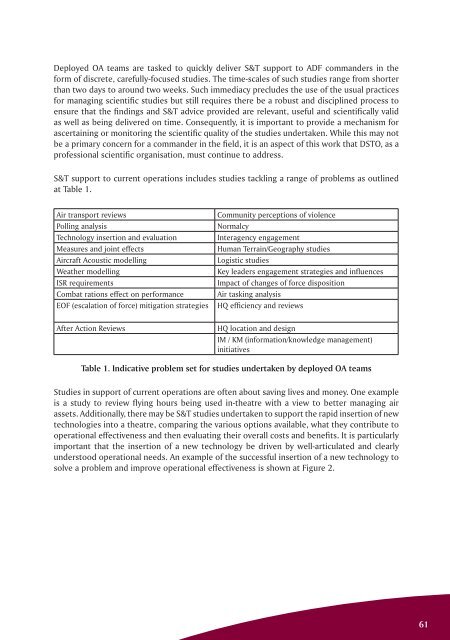ISSUE 182 : Jul/Aug - 2010 - Australian Defence Force Journal
ISSUE 182 : Jul/Aug - 2010 - Australian Defence Force Journal
ISSUE 182 : Jul/Aug - 2010 - Australian Defence Force Journal
You also want an ePaper? Increase the reach of your titles
YUMPU automatically turns print PDFs into web optimized ePapers that Google loves.
Deployed OA teams are tasked to quickly deliver S&T support to ADF commanders in theform of discrete, carefully-focused studies. The time-scales of such studies range from shorterthan two days to around two weeks. Such immediacy precludes the use of the usual practicesfor managing scientific studies but still requires there be a robust and disciplined process toensure that the findings and S&T advice provided are relevant, useful and scientifically validas well as being delivered on time. Consequently, it is important to provide a mechanism forascertaining or monitoring the scientific quality of the studies undertaken. While this may notbe a primary concern for a commander in the field, it is an aspect of this work that DSTO, as aprofessional scientific organisation, must continue to address.S&T support to current operations includes studies tackling a range of problems as outlinedat Table 1.Air transport reviewsPolling analysisTechnology insertion and evaluationMeasures and joint effectsAircraft Acoustic modellingWeather modellingISR requirementsCombat rations effect on performanceEOF (escalation of force) mitigation strategiesAfter Action ReviewsCommunity perceptions of violenceNormalcyInteragency engagementHuman Terrain/Geography studiesLogistic studiesKey leaders engagement strategies and influencesImpact of changes of force dispositionAir tasking analysisHQ efficiency and reviewsHQ location and designIM / KM (information/knowledge management)initiativesTable 1. Indicative problem set for studies undertaken by deployed OA teamsStudies in support of current operations are often about saving lives and money. One exampleis a study to review flying hours being used in-theatre with a view to better managing airassets. Additionally, there may be S&T studies undertaken to support the rapid insertion of newtechnologies into a theatre, comparing the various options available, what they contribute tooperational effectiveness and then evaluating their overall costs and benefits. It is particularlyimportant that the insertion of a new technology be driven by well-articulated and clearlyunderstood operational needs. An example of the successful insertion of a new technology tosolve a problem and improve operational effectiveness is shown at Figure 2.61

















